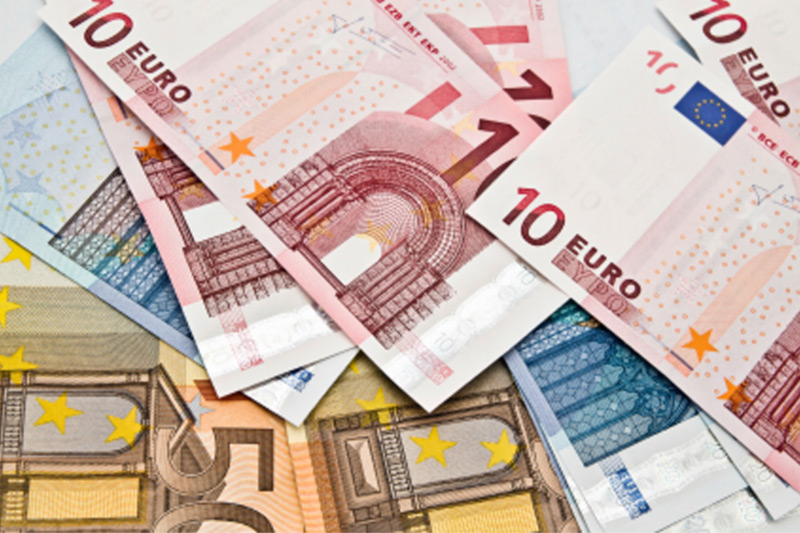Investing.com - The euro slipped lower against the other major currencies on Wednesday, as Tuesday’s robust U.S. retail sales data continued to support the greenback, but losses were limited amid persistent hopes for central bank steps to ease the debt crisis in the euro zone.
During European late morning trade, the euro was lower against the U.S. dollar, with EUR/USD down 0.24% to 1.2286.
Data on Tuesday showed that U.S. retail sales snapped four successive months of declines in July, jumping 0.8%, surpassing expectations for a 0.3% increase and dampening expectations for another round of quantitative easing by the Federal Reserve.
Sentiment on the euro remained fragile, following Tuesday’s data showing the euro zone economy contracted by 0.2% in the three months to June.
Overall market sentiment continued to be underpinned by hopes that recent signs of a slowdown in economic growth would prompt world central banks to implement more easing measures to spur the economic recovery.
The single currency was also down against the pound, with EUR/GBP shedding 0.30% to trade at 0.7836.
Earlier Wednesday, the minutes of the Bank of England’s August meeting showed that policymakers voted unanimously in favor of leaving U.K. interest rates unchanged at 0.5% at its meeting this month and keeping the quantitative easing program at GBP375 billion.
Meanwhile, official data showed that the number of people claiming unemployment benefits in the U.K. unexpectedly fell by 5,900 in July and the nation’s unemployment rate ticked down to 8.1%.
The euro edged lower against the yen, with EUR/JPY dipping 0.09% to 96.91 and remained little changed against the Swiss franc, with EUR/CHF inching up 0.01% to 1.2010.
The shared currency was hovering close to record lows against the Australian, Canadian and New Zealand dollars, with EUR/AUD slipping 0.11% to 1.1733, EUR/CAD down 0.27% to 1.2194 and EUR/NZD falling 0.27% to 1.5255.
In Australia, data showed that the Westpac index of consumer sentiment fell 2.5% in August from July, despite recent interest rate cuts by the Reserve Bank of Australia.
A separate report showed that wage prices in Australia rose 1% in the second quarter, more than the expected 0.8% rise.
Later Wednesday, the U.S. was to release official data on consumer price inflation and industrial production, as well as a report on manufacturing activity in the New York area.
During European late morning trade, the euro was lower against the U.S. dollar, with EUR/USD down 0.24% to 1.2286.
Data on Tuesday showed that U.S. retail sales snapped four successive months of declines in July, jumping 0.8%, surpassing expectations for a 0.3% increase and dampening expectations for another round of quantitative easing by the Federal Reserve.
Sentiment on the euro remained fragile, following Tuesday’s data showing the euro zone economy contracted by 0.2% in the three months to June.
Overall market sentiment continued to be underpinned by hopes that recent signs of a slowdown in economic growth would prompt world central banks to implement more easing measures to spur the economic recovery.
The single currency was also down against the pound, with EUR/GBP shedding 0.30% to trade at 0.7836.
Earlier Wednesday, the minutes of the Bank of England’s August meeting showed that policymakers voted unanimously in favor of leaving U.K. interest rates unchanged at 0.5% at its meeting this month and keeping the quantitative easing program at GBP375 billion.
Meanwhile, official data showed that the number of people claiming unemployment benefits in the U.K. unexpectedly fell by 5,900 in July and the nation’s unemployment rate ticked down to 8.1%.
The euro edged lower against the yen, with EUR/JPY dipping 0.09% to 96.91 and remained little changed against the Swiss franc, with EUR/CHF inching up 0.01% to 1.2010.
The shared currency was hovering close to record lows against the Australian, Canadian and New Zealand dollars, with EUR/AUD slipping 0.11% to 1.1733, EUR/CAD down 0.27% to 1.2194 and EUR/NZD falling 0.27% to 1.5255.
In Australia, data showed that the Westpac index of consumer sentiment fell 2.5% in August from July, despite recent interest rate cuts by the Reserve Bank of Australia.
A separate report showed that wage prices in Australia rose 1% in the second quarter, more than the expected 0.8% rise.
Later Wednesday, the U.S. was to release official data on consumer price inflation and industrial production, as well as a report on manufacturing activity in the New York area.
